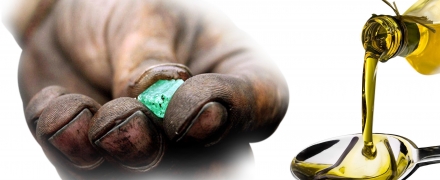open 10 am - 7 pm
laboratory is closed
Gem Cooking

One of the most common refining methods is the impregnation of gemstones with natural vegetable oils and resins.
Despite the fact that natural plant resins are relatively resistant to polymerization and migration within cracks and can be removed from the stone without a trace, natural plant oils are preferred when filling open cracks in colored gemstones. This mainly applies to stones with a refractive index value of up to 1.65-1.69.
Most often, refined, colorless oils are used, the least susceptible to polymerization changes, and the process of impregnating stones with them is carried out in a vacuum heat chamber.
But in practice, stones are impregnated directly at the mine or in the mine in raw raw materials, and the materials and methods of impregnation are very simple and unpretentious, more reminiscent of the economy of an unassuming cook. Rapeseed oil, corn oil and even palm oil are also used, and the processing process resembles the preparation of donuts and French fries, fried in a saucepan with hot oil. Impregnation, as a refinement method, contributes to the fact that the stone becomes more transparent or translucent, since the gas-air mixture present in the cracks is replaced by oil with a refractive index close to that of the stone. Also, if necessary, the refining component can be removed from the cracks and the treatment can be repeated in a specialized laboratory using the recommended components.
Most often, emerald and other beryls, jadeite, jade, less often tourmaline, topaz, quartz and some other stones are subjected to oiling.
В геммологической практике бывают весьма увлекательные случаи с диагностикой ювелирных вставок
Но помимо редкости цвета и высокой стоимости таких камней, многие розовые камни выделяются одной замечательной особенностью – они проявляют плеохроизм, то есть в зависимости от положения осмотра камня он может иметь дополнительные оттенки – оранжевый или пурпурный.
Currently, gemstones are produced by two fundamentally different technological methods - the High Pressure - High Temperature method (“HPHT”, High-pressure & High-temperature) and the Chemical Vapor Deposition (“CVD”, Chemical vapor deposition) method. The "HPHT" method is the most tested classical synthesis method, which can be used both carbon deposition on diamond from flux melts and catalytic reactions. In "CVD" synthesis, diamond growth occurs on a seed during carbon deposition mainly from a gaseous medium at relatively low temperatures and pressures.
Jewelry and precious stones are just such a category of goods, when buying which you need to pay attention to many criteria.
Sogdianite is a rather rare mineral and more often it can be found as a collection material (moreover, in systematic collections), and it is extremely rare in jewelry.






